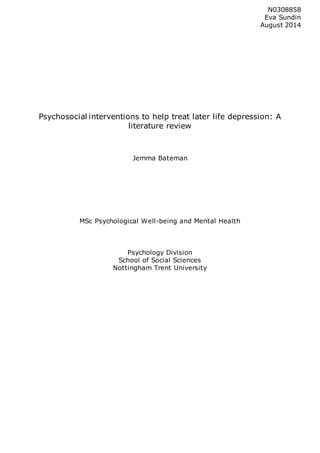Psychosocial interventions may be a safer alternative to antidepressant medication for treating depression in older adults. A literature review found that psychosocial interventions can be effective in reducing depressive symptoms and increasing self-efficacy in elderly populations. The review categorized psychosocial interventions into four groups: self-help, technology-based, social/befriending, and clinical approaches. While more research is still needed, available evidence suggests psychosocial therapies show potential for improving depression outcomes for older adults.






























![30
Mental health foundation (2014). Accessed 26th June 2014. Retrieved from:
http://www.mentalhealth.org.uk/help-information/mental-health-a-z/D/depression/
Morahan-Martin, J. (2005). Internet Abuse Addiction? Disorder? Symptom? Alternative
Explanations?. Social Science Computer Review, 23(1), 39-48.
Muñoz, R. F., Beardslee, W. R., & Leykin, Y. (2012). Major depression can be prevented.
American Psychologist, 67(4), 285.
Mynors-Wallis, L. M., Gath, D. H., Lloyd-Thomas, A. R., & Tomlinson, D. B. M. J. (1995).
Randomised controlled trial comparing problem solving treatment with amitriptyline
and placebo for major depression in primary care. British medical journal ,
310(6977), 441-445.
Mynors-Wallis, L. M., Gath, D. H., Day, A., & Baker, F. (2000). Randomised controlled trial
of problem solving treatment, antidepressant medication, and combined treatment for
major depression in primary care. British medical journal 320(7226), 26-30.
National Health Service Centre for Reviews and Dissemination. (2002). Improving the
recognition and management of depression in primary care. Effective Health Care7,
1-11. Retrieved from: www.mims.co.uk
National Institute of Mental Health (2014). Accessed 1st July 2014.
http://www.nimh.nih.gov/index.shtml . Retrieved from:
http://www.nimh.nih.gov/health/publications/older-adults-and-depression/index.shtml
National Institute for Health and Clinical Excellence. (2004). Depression: management of
depression in primary and secondary care. London: NICE; 2004. (NICE Clinical
Guideline 90). [cited 09 August 2014] Available from
http://www.nice.org.uk/page.redirect?o=cg023
Office For National Statistics (2014). Accessed 15th July 2014. Retrieved from
http://www.ons.gov.uk/ons/rel/rdit2/internet-access---households-and-individuals/2013/stb-
ia-2013.html#tab-Household-Internet-access
Neuberger,J.(2008).Unkind,Risk Averse and Untrusting–If This is Today’s Society,Can We
Change It? The Joseph Rowntree Foundation, York, UK.
McKendree‐Smith, N. L., Floyd, M., & Scogin, F. R. (2003). Self‐administered treatments
for depression: a review. Journal of clinical psychology, 59(3), 275-288
Mead, N., Macdonald, W. Bower, P., Lovell, K., Richards, D., Roberts, C., & Bucknall, A.
(2005). The clinical effectiveness of guided self-help versus waiting-list control in the
management of anxiety and depression: a randomized controlled trial. Psychological
medicine, 35(11), 1633-1643.
Mohr (2012). Accessed 13th June 2014. Retrieved from:
http://www.northwestern.edu/newscenter/stories/2012/02/therapist-phone-mohr.html](https://image.slidesharecdn.com/c3ffc594-cb35-49b8-8fed-a52fcb91605e-150401073053-conversion-gate01/85/N0308858-Project-Report-31-320.jpg)







